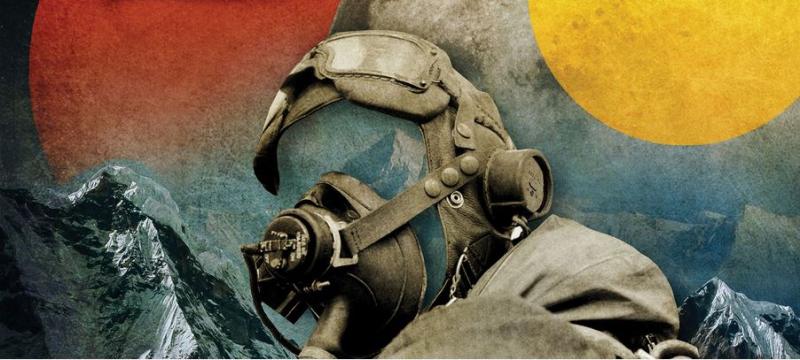Some 83,000 members of the U.S. military are missing. This group tries to bring them home.



June 4, 2018
E
arly on the morning of January 25, 1944, eight young American airmen strode across the gravel of an airfield in Kunming, China, toward a B-24J bomber. Their mission was to fly the 67-foot-long aircraft, its nose bedecked with a picture of a pinup girl and the slogan “Hot as Hell,” over the Himalayas to pick up supplies from British-held India. It was a routine run but still plenty dangerous. The weather over the mountain route, known as the Hump, was fearsomely unpredictable and severe. Some 600 American planes would crash in the area by the war’s end. The men settled into their positions: two pilots, a navigator, a bombardier, a radio operator, a flight engineer, and two gunners. At 7:40 a.m., the plane roared up into the sky. Smooth sailing as they climbed to 15,000 feet. But three hours into the trip, thick clouds rolled in. The pilots could barely see a mile in front of them. Somewhere in that vast mountain range, out of sight and out of touch with their base, the Hot as Hell went down. In 1947, with the fighting over, the United States mounted a campaign to find the bodies of the more than 300 Americans who had gone missing in plane crashes on the Hump. The searchers traveled by truck, mule, and foot, fording rain-swollen rivers and fending off malarial mosquitoes, but never found the spot where the Hot as Hell fell to Earth. The area in which it presumably lay, the search party’s official report declared, “encompasses many thousands of square miles of mountainous jungle terrain, some of it inaccessible, unexplored, and uninhabited.” Their conclusion: “Any further attempt for the recovery of their remains would prove unsuccessful.” Sixty-eight years later, on a sunny October morning, Meghan-Tómasita Cosgriff-Hernández came clambering along a rocky trail 9,400 feet up in the Indian Himalayas. The anthropologist and her 12 teammates had hiked uphill under a glaring sun for more than two days to reach the spot where they now stood. Before them was a steep gully, thick with trees, brush, and boulders—and littered with a weather-beaten propeller, wing, engine, and the other ragged pieces of what had been the Hot as Hell. The group’s mission was as straightforward as it was daunting: search through acres of that jungly growth and unstable scree for the remains of the airplane’s crew. Well, thought Cosgriff-Hernández, looking over the expanse, let’s get to it.

Cosgriff-Hernández’s team was one of many the United States military regularly dispatches all over the world—but these are squads of scientists as well as soldiers. Their task is not killing enemies but rather finding dead Americans. Some 83,000 American military personnel have gone missing in conflicts since World War II—presumed to have died in plane crashes, ship sinkings, and chaotic battles. Dozens of times a year, the Defense POW/MIA Accounting Agency (which goes by the initialism DPAA) sends teams of forensic archaeologists, anthropologists, aircraft experts, and others to scour Vietnamese jungles, European forests, Pacific islands, and other former battle zones for those service members’ remains. Finding the bodies is just the first hurdle; next comes the challenge of using forensic dentistry, DNA analysis, and other techniques to identify to whom those bone fragments and broken teeth belonged. The agency boasts a $112 million annual budget and a staff of about 700, working out of a center in Hawaii and a network of far-flung labs and field bases. At any given time, investigators are working on about 1,200 cases.
The project began after the Vietnam War , when families of missing soldiers pressured the government to figure out what had become of their loved ones. Hundreds of remains from that conflict have since been found and returned to relatives. "Because of that success, later on Congress added the Korean War," says Kelly McKeague, a former Air Force major general who is director of the DPAA. "Then other families started asking, 'What about us?'"
The agency is now officially tasked with providing “the fullest possible accounting” of the fates of missing personnel from the Second World War through today’s conflicts. As many as 39,000 of the total were lost at sea, and the agency does not expect to ever recover their remains. But that still leaves a staggering caseload.
 Article is LOCKED by moderator [smarty_function_ntUser_get_name: user_id or profile_id parameter required]
Article is LOCKED by moderator [smarty_function_ntUser_get_name: user_id or profile_id parameter required]




Good article about a typical recovery of enough bones to make a positive ID by the DPAA. The article is a mixture of adventure,
a small victory for the DPAA and the emotional return of one airman's remains to what is left of his family and friends.
all of our service people deserve to be brought back home to their families no matter how long it takes or how much it costs. although probably impossible in some extreme cases because of the lapse of time, not a one deserves to be left behind.
Thanks to those working to bring closure to military families.
Not everyone, however is impressed with the DPAA, but especially the stone wall known as J-PAC.
Here is a second article about the actual ordeal of trying to get bones exhumed from hundreds of John Doe graves throughout the world,
and the agency's current "logic" for refusing to do so.
Needless to say, this second article expresses the frustration of dealing with the military while both supportive of the body of Hollands work,
it also points out his shortcomings, the typical red tape and ridiculous mistakes by everyday people.
Another long worthwhile read.
I've read a few article about DPAA before. This article was simply wonderful as it gave the reader a very inside view of the importance and danger of this work...
Kudos to all at DPAA and especially Hernandez and her crew on this mission.
Is it worth the cost..Oh, hell yes it is.
Excellent article SP.
YES, YES it IS!
Surprised Fish isn't here /S
Thank you SP
for posting a seed of substance.
You're right .... aaaaagain.
This is a fabulous read, despite it breaking my heart thinking of those who have lost their lives for us. It's the families and their aching souls that reach me the most.
I know this is swerving off topic, but I can't help it. Every man or woman who signs up to give their lives to our military joins the service without knowing where they will be. Their families are just as heroic. This about the civil war:
Cite . Interesting that the Confederate recovery was driven by women volunteers.
Great article, SP. One that everyone should read.
Surviving women, mothers, sisters, wives and daughters had to pick up the pieces of their lives and move on. They located their loved ones who had fallen in battle and brought them home to veterans cemeteries that they funded privately at first. After that they started building memorials and statutes to their fallen heroes, one bake sale at a time.
Increasingly ( it seems ) death on active duty is an inconvenience to some when the body of a fallen hero is aboard a common carrier flight.
smh...
I wonder how many "inconvenienced" passengers think Colin Kaepernick should have been fired for kneeling since it was an affront to their sensibilities. All I know is that every person I've talked to who has served this country regarding the matter believes strongly that they joined the service to keep totalitarians out of our country and keep each of us free to peacefully protest.
Watching these videos made my heart break for these families.